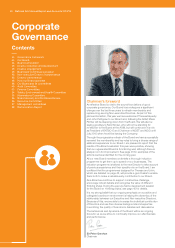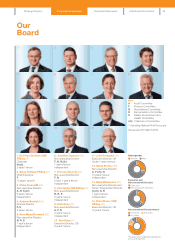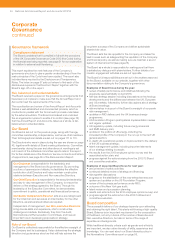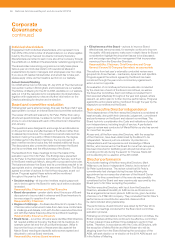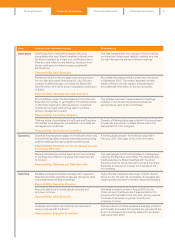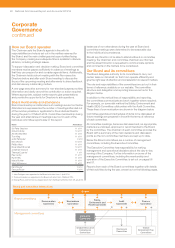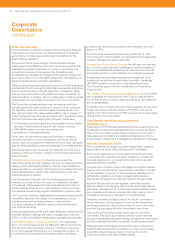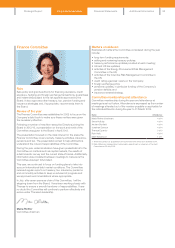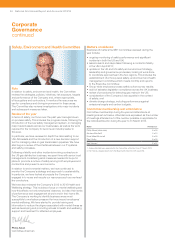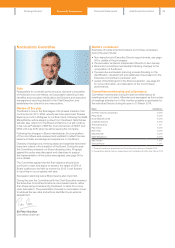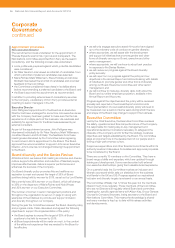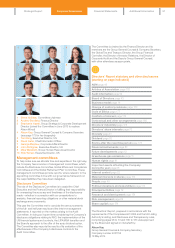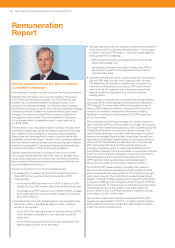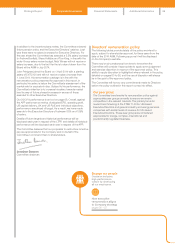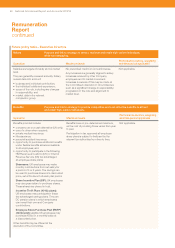National Grid 2014 Annual Report Download - page 52
Download and view the complete annual report
Please find page 52 of the 2014 National Grid annual report below. You can navigate through the pages in the report by either clicking on the pages listed below, or by using the keyword search tool below to find specific information within the annual report.
Corporate
Governance
continued
Financial reporting
The Committee monitors the integrity of the Company’s financial
information and other formal documents relating to its financial
performance. It makes appropriate recommendations to the
Board before publication.
An important factor in the integrity of financial statements is
making sure that suitable and compliant accounting policies are
adopted and applied consistently on a year-on-year basis and
across the Company. In this respect, the Committee also
considered the estimates and judgements made by management
when accounting for non-standard transactions, the treatment of
exceptional items and in provision calculations.
These considerations are supported by input from other assurance
providers such as the group controls, risk management and ethics
and compliance teams, business separation compliance officer,
internal (corporate) audit and the SEH Committee, as well as our
external auditors. In addition, the Committee also considers reports
of theDisclosure Committee. See page 57 for more information.
The Committee reviews and approves the external audit plan
annually (see Audit quality below) and, as part of this, considers
the significant risks upon which the external auditors will focus
their year-end audit. The independent auditors’ report (pages 77
to 80) highlights these risks, some of which led to significant issues
that the Committee discussed during the year. These were:
• US financial controls program (including quality of reconciliation
process, US plant accounting and user access controls);
• LIPA MSA transition contract accounting; and
• presentation of exceptional items.
Other risks, including the accuracy and valuation of treasury
derivative transactions, and management override of internal
control, were not considered in detail by the Committee during the
year as nothing significant arose that warranted Committee attention.
Summarised below are the issues that attracted the most focus,
and time, of the Committee in relation to the financial statements
during the year.
US nancial controls program: the primary focus of the
Committee during the year has been the work to make sure of the
integrity of the new financial system in the US. This included the
measures taken to remediate US financial control deficiencies and
those highlighted as a result of the implementation of the new
enterprise resource system.
Over the course of the year, the Committee requested and
reviewed a number of reports in order to understand the detail
ofthe issues. These issues include the timeliness and quality of
certain balance sheet account reconciliations, and the process
and systems to ensure appropriate capitalisation of labour costs.
The Committee has also challenged and reviewed management’s
remediation plans and the design of compensating controls,
including enhanced analytical reviews to make sure the
Companymaintains an effective internal control environment
overfinancial reporting.
Given the significance of this work, Mark Williamson visited the US
and held detailed meetings with senior management in January
2014 to confirm remediation plans were progressing as expected.
LIPA MSA transition contract accounting: on 31 December
2013,our US business moved the MSA with LIPA to a third party.
This transition was particularly complex. It involved many areas
ofour US business and required us to manage the transition of
more than 2,000 employees, including more than 40 finance
professionals, as well as to provide a new enterprise resource
system to LIPA.
The Committee reviewed the accounting treatment of costs
incurred as part of the transition and agreed that the judgements
made by management were reasonable.
Presentation of exceptional items: at the half year and year end,
the Committee discussed and challenged a detailed analysis of
items to be classified as exceptional to make sure the items did
not include income or costs relating to the underlying business.
In particular, the Committee considered the treatment of the
provision at the half year for gas holder demolition, as well as
LIPAMSA transition and pension costs (described above).
TheCommittee agreed that the classification of these items
isappropriate.
Fair, balanced and understandable assessment: the Committee
has considered the requirement of the Code to ensure that the
Annual Report and Accounts, taken as a whole, is ‘fair, balanced
and understandable’.
In reaching this conclusion the Committee reviewed, among other
things, the impact of the introduction of the RIIO price control
regime in the UK on the Group’s IFRS reported results, see pages
08 and 09 for more information.
Confidential reporting procedures and
whistleblowing
The integrity of the financial statements is further supported by the
confidential reporting and whistleblowing procedures we have in
place. The Committee reviews these procedures once a year to
make sure that complaints are treated confidentially and that a
proportionate, independent investigation is carried out in all cases.
Internal (Corporate) Audit
The Corporate Audit function provides independent, objective
assurance to the Audit, SEH and Executive Committees.
Audit work is delivered by a combination of internal resources
– employees who typically have either a finance or operational
business background – and external sources, where specific
specialist skills are required.
The audit plan contains a mix of risk-based and cyclical reviews
together with a small amount of work that is mandated, typically
byUS regulators. A number of focus areas are identified, such
asfinancial, regulatory and asset management processes.
Appropriate coverage is provided across each of these areas.
Inputs to the plan include risk registers, corporate priorities,
external research of emerging risks and trends and discussions
with senior management. A tool that captures all auditable areas,
prior coverage and inherent process risk is also used to inform
ofaudits that should be undertaken on a cyclical basis.
The plan is reviewed and approved by the Audit Committee in
March each year, with focus given to not only the areas which
arebeing covered but also those that are not, so we can make
sure that the plan aligns with the Committee’s view of risk.
Corporate Audit provides a twice-yearly report to the Audit
Committee. The report summarises common control themes
arising and progress with implementing management action plans,
and also presents information on specific audits as appropriate.
Where specific control issues are identified, senior leaders are
invited to attend the Audit Committee to provide a commentary
around the actions they are taking to improve the control
environment within their area of responsibility.
50 National Grid Annual Report and Accounts 2013/14




